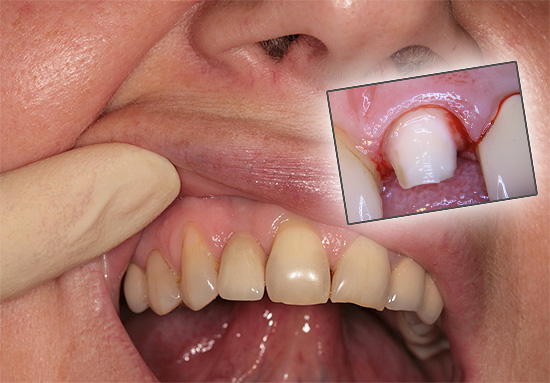
Sometimes after installing a crown on a tooth, a person begins to feel pain: this can be observed both immediately after treatment and after a very long time, up to several years. Many people do not know what to do and try to eliminate such pain in the tooth under the crown at home, resorting to various popular recipes, mouth rinses, but this is not always justifiable and safe, because the causes of the problem can be very different.
Just the same about the causes of toothache under the crown and what to do in such cases, we will continue and talk in more detail.
Especially for those who crave “revenge” on dentists for the deplorable result of work, it will be described in detail when the holder of the crowns is to blame, and when to ask from the orthopedic dentist. It will also be explained such a moment that a tooth prepared for prosthetics with a crown installed on it is the result of the joint work of three people:dentist therapist, dental technician and orthopedist. Therefore, generally speaking, each of them is responsible for the final result.
But first things first…
Why the tooth starts to hurt under the crown
There are certain indications for the preservation of teeth with the help of crowns. A crown is a kind of prosthesis that allows not only to increase the strength of a sealed tooth, but also to act in certain cases as an artificial substitute for it instead of the missing one in the structure called a “bridge” or a bridge-like prosthesis.
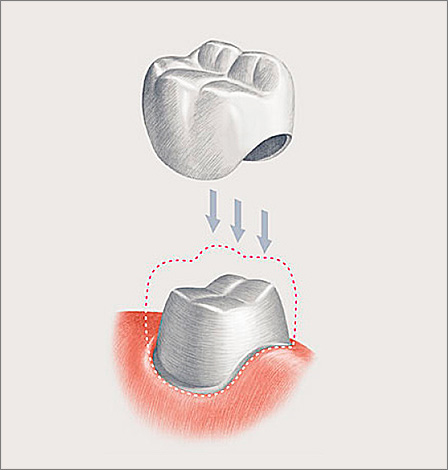

It should be immediately noted that the pain in the tooth under the crown and the feeling of discomfort that arose for a short time after it was fixed to the tooth are completely different things, and the causes of pain in such cases are also very different. Accordingly, at home, it will not always be possible to help the tooth.
However, it is quite obvious that, normally, a tooth with a crown should not hurt. Then there are reasonable questions: where does this pain actually come from, is it acceptable (permissible) and how to understand what is its cause?
There are several reasons that can cause pain in the tooth under the crown.
The first of these is inflammation of the pulp (“nerve”) inside the tooth. Depending on the choice of the type of crown (stamped, metal-ceramic), the approach and tactics of the orthopedic dentist (“prosthetist”), it is sometimes decided to leave the tooth alive, that is, not to remove the “nerve” from it. However, in the process of work, errors in the diagnosis, treatment and treatment of the tooth under the crown may occur, as a result of which sometimes there is pulp inflammation and pain.
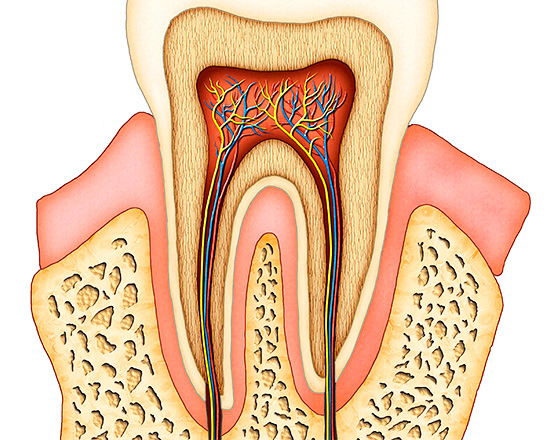
Often this pain is manifested already at the stage of prosthetics, which allows you to make a decision on the removal of the pulp even before the crown is installed. But there are, unfortunately, cases when the tooth begins to hurt after the finished prosthetics.
It is interesting
One of the most common causes of inflammation of the pulp in the tooth is overheating during the "turning" of tooth enamel. Some dentists are still working without water cooling at the tip of the drill, which occasionally causes a “nerve” burn during the processing of hard tissues under the crown and the subsequent necrosis of the pulp.
The metal-ceramic crown requires significant enamel processing from all 5 tooth surfaces. From him, in fact, remains a stumptherefore, the doctor is required to strictly fulfill all working conditions: from knowledge of safety zones to prevent the rotating boron from approaching the pulp chamber, to the use of modern tips adapted to air-to-water cooling of the treated zone from all sides. If at least one condition is violated, the tooth overheats and then begins to ache. Often in such cases, the tooth hurts under the crown of the hot, and the pain does not go away for a long time after the removal of the source of irritation, and often intensifies at night.
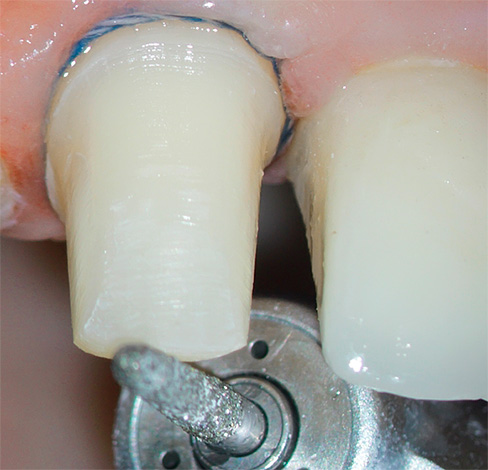
Pulpitis in a live tooth under the crown may also occur due to caries.
However, a tooth with a removed “nerve” can also begin to hurt under the crown. As a rule, the reason for this is poor-quality tooth preparation by a dentist-therapist before prosthetics.
Possible mistakes that in this case can lead to subsequent pain under the crown, many:
- poor processing of the channels and leaving the infection (bacteria) inside them;
- pulp not fully extracted from the channel (s);
- a piece of tool in the channel;
- creating a perforation (hole) in the wall of the tooth or root (for some, it seems that they have a root of the tooth under the crown);
- not bringing or excessive removal of the filling material beyond the root
and others. Sometimes there can be observed both constant severe aching pain, and pain only with pressure on the crown.
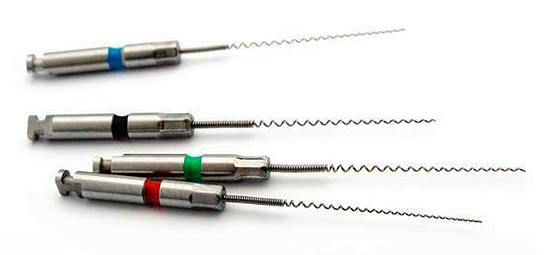

If at the stage of prosthetics, the dentist-orthopedist immediately notices the mistakes of the dentist-therapist, then even before installing the crown, he asks either to re-tooth the tooth, or sometimes, depending on the situation, insists on removing the tooth from the dentist-surgeon, which changes the further tactics of the orthopedic treatment.
It is interesting
There are situations when the dentist-therapist, due to lack of experience, qualifications, equipment in the clinic or a complex arrangement of canals during intra-canal treatment of a tooth prepared for prosthetics, makes mistakes that are not compatible with the further preservation of the tooth. Conscientious and honest doctors give the patient true information about cause-effect relationships, but more often, an unsuspecting client is told that the person himself has delayed his problem to such a state that there is already a “cyst”,and started treatment did not produce results.
Well, finally, the cause of the pain may simply be an incorrectly installed crown.
In some cases this is due to overbite of the crown on the bite: the patient feels discomfort, the teeth do not close. The tactic of an orthopedist to send a patient home “to get used to” crowns that are obviously inflated by bite is wrong. The fact is that with such a crown a traumatic inflammation of the root of the tooth, as well as problems with the temporomandibular joint, may occur after a while. In this case, a person cannot understand for a long time why the tooth ached under the crown, as sometimes it takes more than one month before the errors of the work of an orthopedic surgeon come up.
There are situations when, under the crown, it is not the tooth that starts to hurt, but the gum. The crown fixed on the tooth may unnecessarily enter its edge under the gum, or, conversely, not significantly reach its edge.
In the first variant, a permanent injury with a sharp edge forms a local inflammation, and the inflammation is accompanied by pain, which “gives out” to the tooth.As a result, it seems to a person that it is the tooth that hurts under the crown, although the reason is in the gum.
The photo below shows an example of inflammation of the gums in contact with crowns:
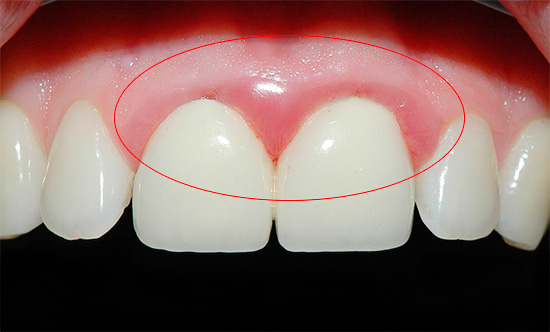
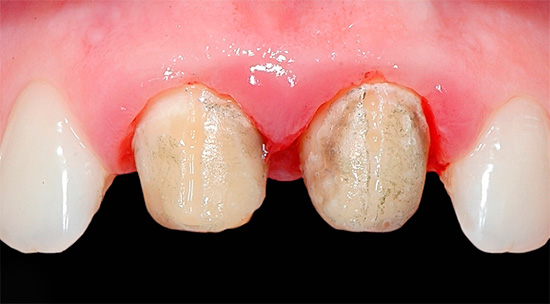
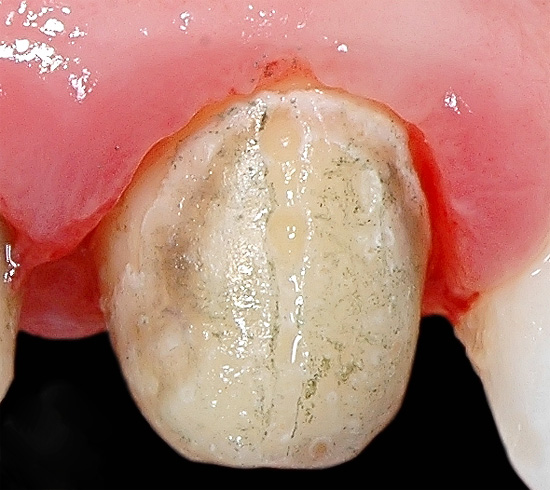
In the second variant (when the crown does not reach the gum), pain usually does not occur soon. Frequent delay of food between the gum and the edge of the crown can provoke in the future the same inflammation and pain as in the first case, but caries on the tooth are most likely to develop, leading to a gradual destruction of hard tissues under the crown with a pain reaction to hot, cold, pressure and other irritants.
Folk remedies for pain under the crown
So, suppose you have a tooth ache under the crown and you don’t know what to do: go to the doctor right away, or try to relieve the pain at home first and see if the problem disappears later on by itself.
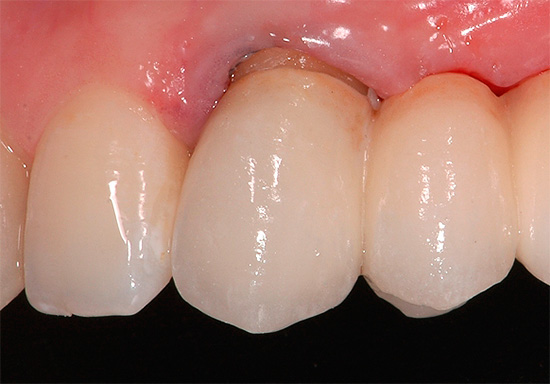
Here it is important to understand that even well-established crowns on the teeth can cause mild painful sensations after prosthetics (both permanent and appearing only with pressure), but not more than 1-3 days while the gingival mucosa is adapted to them. Therefore, folk remedies in this case will fall just in time. However, for longer pains, as well as for very severe pains, you should make an appointment with a dentist.
There are many methods that allow the pain under the crown to be reduced or even disappear completely. And perhaps the most popular method for using at home is rinsing, although not everyone knows what means to choose, how to brew broths and how to rinse your mouth.
The first place in terms of efficiency and ease of use is sage.

It is interesting
For a long time sage has been used by healers, considering it to be the best green doctor. Even the name "sage" is translated from ancient Greek as "sun", "health". Sage leaves contain flavonoids and phytoncides. A significant content is made up of organic acids, as well as vitamins P and PP. Sage has anti-inflammatory, hemostatic and antimicrobial action, which is great for relieving toothache and pain in the gums.
To prepare the infusion, you need to measure one tablespoon of sage herb, pour one cup of boiling water from the kettle and insist the resulting solution for 15 minutes.After that, rinse your mouth with warm infusion at least 5 times within 30 minutes. The pain most quickly disappears if the gum is inflamed from the crown.
Oregano infusion is also sometimes very well suited to soothe a toothache under the crown, especially if it irritates the gums.

On a note
Oregano contains almost all of the same ingredients as sage. Particularly strongly affect its medicinal properties such compounds as: thymol and carvacrol (antiseptics), volatile (also inhibit the growth and kill bacteria and fungi). Some people even think that oregano can easily replace antibiotics.
To make an infusion of oregano, one and a half tablespoons of herbs should be poured with a glass of boiling water and allowed to cool. To relieve pain, rinsing should be done 5-7 times per hour.
However, perhaps the most popular in the application - it is soda rinsing. The advantage of baking soda, as a folk remedy, is that during rinsing it with a solution decreases the inflammation of the gums, and the number of viable microbes significantly decreases, with the result that the pain gradually subsides.

To prepare a solution of soda for rinsing the mouth is not difficult: it is enough to dissolve a teaspoon of soda powder in a glass of warm water. But the rinsing aimed at removing the toothache under the crown - this is almost the whole art.
It is necessary to take a little warm soda solution in your mouth and place it in your mouth so that its main part is near the diseased tooth. A few seconds is to hold the portion, and then spit it out and rinse again the same way, until the entire prepared solution is used up. Usually, the tooth gradually ceases to hurt under the crown within a few minutes after the start of rinsing.
Home first aid kit for toothache
As noted above, after setting a tooth on a crown, pain of a different etiology may occur. However, whatever the reason, it’s natural to want to get rid of unpleasant sensations as quickly as possible, so you can turn to modern anesthetics that are in almost every home medicine chest.
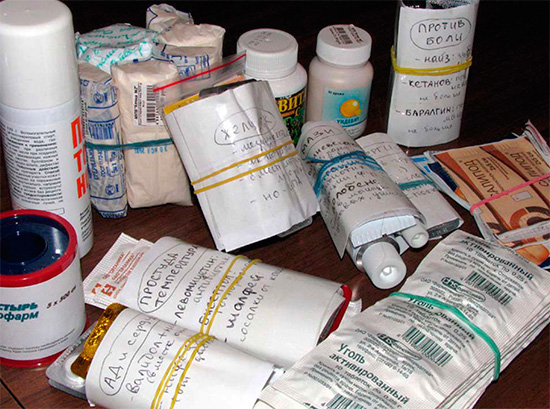
Dentists most often prescribe the following drugs as an additional therapy after dental treatment and fixing crowns as painkillers:
- Ketanov;
- Ketorol;
- Ketorolac;
- Tempalgin;
- Nurofen.
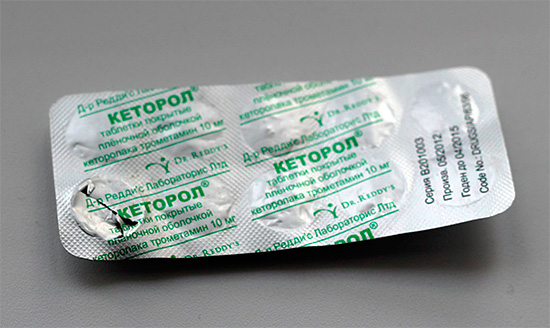
The first three of them are sold in pharmacies by prescription only.
It is interesting
Analgin is perhaps the most controversial anesthetic that, however, is found in almost every Russian house, which cannot be said about dozens of developed countries that have long been abandoned because of the possibility of dangerous complications. Back in 1970, the World Health Organization recommended abandoning this pain medication. Analgin is not for sale in Canada, Great Britain, Austria, Denmark, the United States, Japan and some other countries because of the risk of agranulocytosis, a disease associated with a decrease in neutrophils in the blood, which makes the body susceptible to bacterial and fungal infections.
Antihistamines are drugs that reduce the sensitivity of the human body to damage and infectious processes. During inflammation, the so-called “microbial allergy” occurs, and histamine increases it. To keep inflammation under control, antihistamines have been created, which dentists also often prescribe.

The pain that occurs under the crown is most often the result of inflammation.Histamine is a substance that provokes the mechanisms that cause pain, and an antihistamine allows you to influence histamine receptors.
If a tooth hurts under the crown, then as an additional therapy, course therapy with such antihistaminic drugs as:
- Diazolin;
- Tavegil;
- Suprastin;
- Diphenhydramine;
- Claritin;
- Zyrtec
And etc.
Before using any medication, you should consult a doctor (you can and not a dentist). It must be remembered that many antihistamines and painkillers have a sedative effect or reduce concentration.
Treatment of a tooth under the crown at the dentist: what can you expect at the clinic
Each type of crowns has its own shelf life, so it is important to soberly assess the situation when the pain under a stamped (“golden”) crown occurred after 10-15 years of its operation, and under cermet - after 15-20 years. That is, one should not rely on the fact that for a long period of time under the crown with a tooth nothing will happen and it will not get sick.

Another thing is, if the tooth under the crown starts to hurt immediately or soon after its installation, then it is important to understand the real reasons for this.Of course, it is difficult to determine the problem on your own at home. Therefore, it is still useful to rely on the conscience and honor of your doctor, consult with him, take pictures of your teeth, if necessary, and determine what the cause of the pain is.
A professional doctor will not only find the causal factor of pain that has arisen in the tooth under the crown, but also outlines a retreatment plan if there are errors: starting from replacing a traumatic or overcrown crown, and ending with re-filling of the canals.
The final option is to remove a damaged tooth and plan a new prosthesis with the new data.

Clinical case
A 35-year-old man came to a dentist with complaints of swelling of the gums in the area of the left tooth from below, which periodically passes by itself. From the case history: the tooth was previously treated in the canals, the metal-ceramic crown was set about 2 years ago. The data of visual inspection, percussion, EDI and X-ray diagnostics showed that the tooth is under the crown with a nerve removed, and in the area of the anterior root of the 3.6 tooth (lower left, sixth in a row) granuloma is visible, which represents a rounded dark area in the image.The surrounding tissue near the rear root is within normal limits.
The causes of pain are quite obvious: in the front root, the filling material passed only a little more than 50% of the canal, so it can be assumed that during the work a number of problems arose associated with the passage of the canal, its expansion, washing and filling, which later led to reproduction bacteria in the non-sealed area.
The posterior root is sealed almost to the apex, that is, without reaching the visible radiological apex of about 1 mm. Therefore, there is no serious problem.
Tactic treatment. To eliminate the direct sources of pain in the form of inflammation of the root at the apex, a phased treatment was carried out:
- Boron preparation through the crown;
- The opening of the mouth of the channel in the problematic front root;
- The passage of the channel and expansion, not reaching the apex by 20-30%;
- Soft-core obturator filling to the required length;
- Resection (clipping) of the apex of the anterior root;
- Control pictures after treatment and in a year;
- Replacement crown.
Preventing toothache under the crown
To the tooth under the crown is not ached, it is enough to follow the recommendations of the doctor to care for him.Crowns should be the same as their teeth, cleaned regularly and at least 2 times a day. It is especially important to clean the plaque from the gaps between the teeth and near the gum edge - the place of the greatest probability of accumulation of food debris.

To do this, suitable hygiene products such as: toothbrush, dental floss (floss), and in extreme cases - a toothpick. It is categorically impossible to gnaw crowns seeds, mosly, hard nuts, fruit pits, etc., as this often leads to breakage of the crown and provokes further severe pain under it.
Even if there is no pain in the tooth under the installed crown, nevertheless, you should visit your doctor at least 2 times a year to monitor the quality of the prosthesis.
Useful video: why there is pain in the tooth under the crown and how is treatment in such a situation
Why do old crowns harm health?


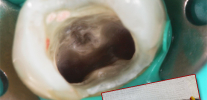
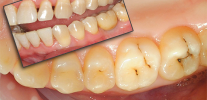
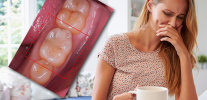
They put the crowns, they began to hurt a month later. What to do?
Visit a doctor. Himself here to do nothing. This is the teeth, home methods will not help. It’s good that they put the crown on me successfully, although the doctor warned that gum inflammation under the crown is possible. And what then will need to take some therapeutic solution and rinse to relieve inflammation. I prefer periodontal disease, it helps a lot and the teeth with fillings do not darken from it.
My teeth hurt a lot. I do not sleep at night, what should I do? I take pills endlessly, it hurts a lot, it hurts ... What should I do?
Pry up every one and put the prosthesis if the teeth hurt ...
I put the bridge on the living teeth. Constantly whining one tooth. Then the tooth starts hurting below. Then the jaw starts to hurt, and then everything hurts. The tooth does not react to hot, cold or pressure. From the hot, on the contrary, it calms down. The crown is very comfortable. What is going on?
Mom constantly has a toothache under the crown, what to do?
Hello Pavel! Everything is simple here: you must take a snapshot of the tooth (the dentist can write the number of the tooth for the radiologist at the consultation), then you should come to the attending dentist with the picture. He will analyze the snapshot data and decide what is best to do. If there are cysts on the root or something like that, then you will need to remove the crown and assess the situation.
If everything is “rotted” under the crown, tooth extraction and re-prosthesis will be needed. If it turns out that the tooth is alive, you should also remove the crown and treat the canals with the subsequent installation of a filling and a new crown. Through the crown, single-channel teeth can sometimes be treated,but according to the protocol, this is not the right approach, since it does not always work out in such a way to qualitatively process both the carious cavity and the channel itself. Moreover, even the “hole” fixed in the crown still affects the strength characteristics of the orthopedic structure in the future.
The overall result is this: for pain in the tooth under the crown, a diagnostic picture is always taken, the crown is removed and the tooth is treated (or treated) according to the situation. In rare cases, immediately after analyzing the image, the tooth is removed along with the crown (surgical care).
Yesterday, we put 4 crowns on the front lower living teeth. Immediately she told the doctor that her teeth sore badly, but he replied that pain would still be felt for a day. Almost a day passed, the pain subsided, but it still hurts to bite off the food, and it is painful to touch the teeth with the tongue. Advise what to do?
Hello, Love! Usually, with constant fixation of the crowns, pain really disappears during the day. However, it happens that even if the doctor did everything correctly, the individual reaction of the gums lasts up to 2-3 days.This is especially pronounced in gingivitis and periodontitis, when the gum itself is extremely sensitive to any interventions in its relation. Unfortunately, you didn’t clarify whether you were “nerved” or not in your teeth. That would clarify a lot.
So far, based on your data, the assumption is reduced only to the reaction of the mucous membranes, but information about the treatment of canals requires you to clarify. I can not say that the best consultation that gives the completeness of the picture - this is obtained from your or other dentist in the chair. I wish you a speedy solution to the problem!
Good day! In January 2016, he placed 2 crowns on the chewing lower teeth (a crown on 2 teeth at once). The doctor said that cleaning the canals is not necessary if they are not disturbed. A couple of days ago I began to feel pain in one of the prosthetic teeth while chewing food. He does not react to hot and cold teeth, only to chewing food. Question: if now to clean the canal of this tooth, the installation of a new crown at the same doctor after cleaning the canals should be covered by the warranty?
Hello, Alexander! You correctly assess the situation: the appearance of pain under the crowns is not the norm. The problem is to correctly diagnose the causative tooth.Sometimes the pain "gives" from those teeth that you do not even think about. If it is found a tooth under the crown (the picture can clarify a number of points), then everything depends on the policy of the clinic. The warranty documents indicate the points that fall under it. There your signature and read what falls under it, and what does not, you can, but in some cases only the drafter and the medical lawyer can understand. As far as I know, a decent clinic is responsible for all the work: from preparation for the crown to the last stage of fixation. In fact, it happens that the warranty refers precisely to the fact of damage to the crown or its loss. That is, the possible appearance of pain under the crown is attributed to the individual characteristics of the body: the blame is placed on the person himself. There are very subtle nuances that are first solved in the clinic, analyzed and so on, and then the assessment of the work of the institution and the conscience of the director with the staff are given. I’ll say right away that with a legally correctly drafted contract document (as it happens) for the services provided, it is almost always expensive and of little prospect to win the case through the court.
Hello! A week ago, I put cermets on my upper teeth. After a time, when I eat warm or hot food, one tooth under the crown starts to bake, and then it hurts to bite. The pain goes away after drinking cold water ... The nerves under the crown were removed. What should I do?
Hello! You now call the symptoms of exacerbation of chronic periodontitis. If you translate into human language: some of the "dead" teeth under the crown presumably have a deviation in the treatment carried out. There are many options: either you forgot to process the canal in the tooth (more precisely, they didn’t find the canal), broke the instrument in the canal, unnecessarily removed the filling material or left the canal (s) half-empty, could not get through the canal along the entire length, did not treat it sufficiently, did not treat the inflammatory hearth (if there was one at the root of a tooth), etc. The final diagnosis can only be made by a doctor, and the most difficult thing will be to find the causative tooth and re-heal it. After all, this will require removal of the crown, since through ceramics the treatment is difficult, to say the least.
Hello! On 23.07, the lower 6 under the crown ached very much, made an x-ray, the doctor said, that she had a pain reliever, and she probably blew. The pain increased for 2 days, eventually went to another doctor: by tapping, she determined that a nerve had inflamed at 7, removed the filling, put the medicine, said to come in 3 days. All these days on painkillers, the pain gave in the ear, temple. She cleaned the channels at the appointed time, sealed them and put a seal, warned that she could ache a little for a week. The pain subsided every day, but the discomfort was considerable, she took pain medication. And now at 6, under the crown, there was an unpleasant smell, a little gum subsided and the feeling that the tooth under the crown became slightly mobile, and when pressed, pain appeared. Please tell me what to do? Thank you in advance for your response.
You need to go to the doctor, and not ask for help on the forum. With the "seven" you had one problem, and with the "six" - another.
Hello! Not knowing in detail your clinical situation, it is difficult to judge the tactics of the doctor. If there is a problem in tooth 6, then it is important to remove the crown and analyze the situation without the crown. A large role may have a diagnostic snapshot of teeth.It is important to determine the problem tooth. Unfortunately, according to the description, it is impossible to make a diagnosis and prescribe treatment. Trust the dentist.
In April, she put two crowns on chewing teeth. In the last week I feel a nagging pain beneath them.
They began to disturb the teeth under the crown, took a picture, and I can’t recover all day: almost all the channels under the crown are empty or half-empty, and another tool in the channel ((And the crowns on the metal tab, the doctor said that they can not be removed, the roots can crack. I remember that they cleaned and sealed all the channels, does it happen that they were empty? And what should I do now? ((
Hello! If there are fragments of a tool in a channel, then they cannot be called empty. I think that the dentist either failed, due to some reasons, to push the material into the tooth canals, and it “stuck” near the mouths of the canals, or the tooth was filled with non-radiopaque material, that is, it is difficult to assess it in the picture.
About the complexity associated with the tab - the dentist assesses the risks and partly rights.Another question is that you have the opportunity to get advice on your situation from 2-3 more dentists who work in clinics where there is equipment and tools for extracting tabs with minimal risks and reseating channels again. The tool must be removed from the canal: it is best to use the services of canal treatment under a microscope and with the direct participation of ultrasound equipment. This is an expensive procedure, as retreatment (saving a tooth from removal) is always a responsible and difficult process, even for a qualified doctor, if the necessary technical base is available.
How did you solve the question?
Hello! Advise what to do: there is a bridge on the upper jaw (metal ceramics) for 4 years, and now it hurts a little higher than the tooth, closer to the nasal cavity. I rinse, but the pain does not subside. Began to drink painkillers. Thank.
Hello! Take a picture and send to the post office (or provide as a link) if you want to understand in absentia. Anyway,The fate of the tooth under one of the crowns of the bridge is as follows: after removing this orthopedic structure and diagnosing the teeth from the image, you will be given either retreatment of the problem tooth, or its removal, if it is no longer possible to save it. Painkillers are a waste of time and chemistry in the body. Moreover, the tooth is waiting for your attention and "voices" about the exacerbation of chronic periodontitis. So far, no matter what, except for the causal tooth. Thanks for asking.
Hello! A year ago, I put a metal-ceramic bridge, one sealed and one canine. After that, pain in the filled tooth gradually began. I can not eat normally, it hurts a lot, my temples ache. I went to the dentist, did not say it. He said that this is because of the lower carious teeth. Tell me, please, I do not know what to do.
Hello! In your words, I have no reason not to believe your doctor. Let me explain why: the fact is that the pain in the carious tooth, in which the infection fell into the pulp, can radiate to the treated one. That is, one tooth can ache, and give to the next or even to another jaw.
On the other hand, the doctor may be a person interested and hide the real situation from you.Maybe you are right, and the case is in the tooth, which stands under the metal-ceramic.
My advice would be the following: be sure to take pictures of the teeth under the bridge (two teeth) and go to the dentists. Moreover, you can attach pictures here, via mail (see “Feedback” section). Otherwise, contact 2-3 independent dentists and get their advice. Consultations are free at many clinics. This will provide an opportunity to get at least 2 of the same opinion and get the right treatment for exactly the tooth that is bothering.
Four years have passed since the crowns were placed on the last teeth, including the wisdom tooth. Today, the last tooth hurts a lot, I don’t know what to do. Tell me, please, what should I do? So you do not want to shoot crowns.
Hello, 2 years ago they put me a bridge on 2 living teeth, one of which is a wisdom tooth. This wisdom tooth is tormenting me with pain for 4 nights already, and the pain spreads to the upper teeth and the lower row of this side. It only costs me to lie down, as the pain arises, while sitting and standing there is no pain. What should I do?
Hello! I think that it will be necessary to remove the bridge and resolve the issue with the treatment of the tooth (and maybe with the removal, so far I can’t say for sure about the verdict, as this is decided by the dentist at the internal reception). Previously similar to pulput pain. To cure a wisdom tooth through a crown of a bridge, firstly, it is technically problematic, and secondly, to “perforate” the crown at your own risk and then to patch it with a filling is an unreasonable and risky practice in dentistry. So the best option is to remove the bridge and solve the problem with a wisdom tooth and then re-prosthesis.
Good day! Dear Svyatoslav Gennadievich, I have a bridge (from 2011) on the right above, from 3 to 7 (metal crowns). About a week ago, ill 7, under the crown. The pain intensified when chewing, chewing food only on the left side. Twice I took 1 tablet of pentalgin, for the night, the pain gradually disappeared. Last week, the tooth does not hurt at all, I chew food, as before. I understand that it is necessary to diagnose, but once again there is no desire to disrupt the bridge. In this regard, the question: is it possible to take an X-ray snapshot of the tooth through the crown without removing the bridge? Or just have nothing to do, until again there is pain? Thank you for your attention!
Hello! Without a doubt, the tooth should be treated (or retreat, if it was previously treated in the canals). If you leave everything as it is, then in the future you risk either to grow a cyst on the root of the tooth, or to get purulent complication on the floor of the face. As for X-rays, a snapshot even through the crown can help determine what is happening with the canals of the tooth and how bad everything is outside the root (if there is an inflammatory process). My final answer is: you can make a snapshot, you need to treat a tooth (or delete it already - it depends on the situation).
Hello! About 4 years ago, the bridge was put on the top 12-11-21-22. 21 - absent. About 2 years ago there were pains in the cold at 12-11, which after a couple of days passed by themselves. Now, it also began to hurt after a long stay in the bitter cold, and now for a week without going out. It also hurts 42. There is almost no sensitivity to cold / hot food, but it feels like 12-11 under the crown seems to be swollen. Help, please, tell me, what could be the reason and what to do?
Hello! There are two assumptions. Most of all I tend to exacerbate chronic periodontitis. This diagnosis refers to an inflammatory process at the root of a tooth, when a bacterial infection accumulates in the canal, turning its contents most often into purulent exudate. To a lesser extent, I think of pulpitis - inflammation of a “nerve” in one of two living teeth. There is a suspicion that you have already had your teeth treated in the canals, but so far I cannot confirm or deny this fact without a photo. I don’t think that both teeth are to blame, although sometimes it happens that a pronounced acute process takes place in one tooth, and in the other there is a place to be chronic. To establish the exact cause, you need a snapshot of the tooth for diagnostic analysis (you can send me by mail site). If you have a picture, you can talk about what to do next. One thing I can say for sure: the bridge will have to be removed, the teeth (if possible) to heal or hold the primary canal treatment, and then make a new bridge. The option of “knocking out” an old bridge with its reinstallation is doubtful, risky and may have negative consequences for the future.The sooner you deal with this problem, the better. Good luck!
Hello, Svyatoslav Gennadyevich! I rinsed with propolis tincture and forgot about the fact that something hurt))
Hello! Well, but still keep in mind that you removed the effect (pain), and the reason remained. Most likely, repeated manifestations of the inflammatory process will not take long to wait. In rare cases, it can “get lucky”, and there will be no visible problems for many years. However, many people because of the necessity of maxillofacial cyst surgery (expanded over the years) after such a long wait do not consider this to be lucky. Most often, a repeat occurs in the next 1-2 years. The main thing - you are warned, and the rest - all the will of immunity, infection and its activity.
Good morning! I want to know the opinions of independent experts. Three years ago he put cermet crowns. 5 days ago I felt pain in one place, on which stands a crown. I went to the doctor. Take a picture. Everything is fine there, the channels are completely sealed, there are no black spots.The doctor told me that it was a cold (the gums were slightly swollen). Prescribed a bunch of antibiotics. After 3 days of treatment, my gums swelled up, all the pain went there, but the discomfort in the tooth remained. Phoned today with the administrator of the clinic. She told me to wait until dinner. In addition, she added that they will not remove the crowns, but, most likely, they will send me to a surgeon to remove the flux. Is it possible to consult with you? Will this situation not happen again after a while, since they don’t want to remove crowns?
Hello! If, as you have described, you have a flux (periostitis in professional language), then I will say in secret: the tactics of the doctors of the polyclinic are not correct. Let me explain how the situation is today in many public institutions (hospitals, polyclinics). So, you have a tooth that is under the crown and has an inflammatory focus on the root (in more rare cases, there may be a problem with the tooth that is next to the one under the crown). I am almost sure that the canals in the tooth under the crown are not filled as well as doctors think, or there is another problem that caused an infectious process in the canals that spread beyond the apex of the roots.
Why do doctors not want to remove the crown, carry out anti-inflammatory treatment and achieve a positive result in the long term? Most often, budget dentistry simply does not have the necessary equipment for this, and there is also no necessary tools and time (15-20 minutes per patient is given for the norms, and this work takes at least 1-1.5 hours). Perhaps there is no desire, because doctors in such institutions are overloaded with work and unnecessary papers. I am almost sure that several factors are felt at once in this clinic, due to which it is much easier to “release pus” by removing the flux and preserve the chronic process until the next exacerbation. Often, dentists hope that a fistulous passage will occur on the gum, through which pus will be evacuated for many years, when you catch a cold, freeze your legs, get stressed, strongly overload your tooth with hard food, etc.
The most interesting thing is that you, on the whole, correctly understand that the infection in the causal tooth, near which the flux arose, is not going anywhere by itself. Yes, dentists are not from a good life (almost sure) offer to remove only the symptoms,but do you agree to follow the path they propose? I recommend going to a private clinic, where there are incomparably more chances to find a specialist and decent equipment for retreatment of even a complex tooth. Crowns will have to be removed, of course, if the causative tooth is under one of them. Good luck!
Good afternoon, dear doctor! 2 months ago, I installed a crown (solid) on the 4 front upper teeth. Both deuces were dead and with old light composite. They installed titanium strong pins. And both odnorki were live and white. There was a small caries on the inside on one of them. They installed the usual studs of the dentist (Shaitan lured me to put crowns on all 4 teeth. Since the orthopedic surgeon supported my desire, since all the teeth would be equally beautiful and of the same color).
When the fitting showed me the result, the teeth turned out to be yellow! Moreover, they sent home to get used to, and of all the 4 teeth, only one tooth is squeezed with the lower teeth. When biting, everyone else swings with a rocker and sucks off the gums. The pain appeared periodically in this closing tooth. And in recent days is constant.And also there was a fetid odor and white bloom. Every day I take off and clean the ceramics inside and the stumps of the teeth themselves.
Turned odnderki broke off on the second day after installation on a temporary cement. So she went a month until the whole construction was removed.
I am pregnant on the 6th month. Can I do an x-ray? Do I have to replace the color on the crown, if I immediately expressed my discontent with the fitting? And why did a pus-like plaque appear on the sides? Thank you so much.
Hello! With regard to odor and plaque - moving crowns and bridges will inevitably become a repository for food particles and bacteria from the oral cavity, which creates an unpleasant odor. In general, you have described many points that speak about obvious mistakes on the part of the doctor: 1. Incorrect selection of the color of ceramics; 2. Rapid disintegration of the prosthesis (albeit on temporary cement); 3. Incorrectly modeled contacts on the front teeth (this, most likely, contributed to the fact that “grinded odnderki broken off”).
While there is an opportunity, demand a quality job. Or return the money spent for such “work” and prostheticsanother orthopedic dentist (if at the initial stage of prosthetics there are so many jambs, then, perhaps, it still makes sense to change the doctor).
As for X-rays, “film” X-rays should not be performed at the stage of pregnancy (6 months). Maybe there are no big risks, but radiologists will not take such responsibility. In the later stages, viziografiya is possible - an x-ray of a tooth using computer sensors. It will be necessary to negotiate individually anyway, since even those doctors who are engaged in this do not always make compromises, knowing the behavior of women, who, if something happens, can blame this instance for any sins for no good reason.
Color must be replaced at the request of the client, as they must take into account your opinion for your money. I think that here you can agree with the doctor and come to a definite agreement.
Hello! I put the crown 2 weeks ago, and now a tooth ached under it. After examination, the doctor suggested to remove the tooth, referring to the fact that it was initially not very good. Tell me, is there any point in trying to redo the crown?
Hello! Unfortunately, I do not know exactly what reasons your doctor is guided in his decisions. Here you need an inspection and, most likely, a snapshot of the tooth root. Only after this you can give a flick: remove or not the tooth. It is strange that the doctor obviously "controversial" tooth could not assess in time, even before the installation of the crown. It is best to get examined by another orthopedic dentist: check the tooth for mobility, with percussion, palpation of the gums near the root and in the picture (most likely required). It is better to have two or three consultations, and to draw conclusions from them. The tooth is examined comprehensively, and the conclusions must be based on something more substantial than on the simple phrase “bad tooth”.
Good day! Put on the entire upper jaw crowns of zirconium. Bottom right three crowns on the chewing teeth. Raised the bite. Two weeks later, two balls on the lymph nodes began to appear on the right, and swelling near the ear from the cheek. With teeth, in principle, everything is fine, bite does not hurt. Treated with ciprofloxacin, lymph nodes returned to normal. But after a fortnight the balls appeared and swelling at the ear. I went to the orthopedist again - he said that everything was fine.Pus is nowhere, saliva is clean. What could it be? Maybe the bite was overstated? And yet, one living tooth, on which a similar crown was installed, began to react to the cold one, while turning it was very sick, although the orthopedist said that the crown would cover it and there would be no reaction.
Hello! Normally crowned teeth should not react to cold. If there are nearby living teeth, then you should pay attention to them: maybe there is a caries or non-carious defect (abrasion, erosion, etc.). When stating the fact that the reaction is associated with the tooth on which the crown is installed, you will have to remove it and redo everything according to the rules, since it is not worth your further agony. Especially since the question arises: where does this completely covered tooth miss the stimulus?
As for the lymph nodes - it is more difficult. If the antibacterial drug helped, then most likely there was an infection. However, there are times when it is not related to teeth. If, nevertheless, this problem comes from the teeth, then it will be difficult to find out the provocateur: a panoramic image partly answers the questions, or a CT scan of the teeth (full diagnosis).In addition, the overbite of the bite is a stress for the joint, and, in principle, the inflammatory process in the TMJ could take place against the background of a microtrauma. So there are still more questions than answers, and diagnostics are required. I understand that this question is central to you, but for now I can only say that it is worth looking for a living tooth with destruction, or to remove the crown and redo the work, if it turns out that the problem tooth is just under the crown.
Hello, Svyatoslav Gennadyevich! I put a ceramic crown on the upper molar tooth about 4 years ago. All this time, the tooth did not bother. For several days now, the aching pain under the tooth, which is given to the adjacent teeth and to the head. An x-ray was done, one dentist advised to re-tooth or remove a tooth, while another dentist suggested cleaning the pockets of this and neighboring teeth. Although the picture does not show inflammation, the nerve is removed, and the gum inflammation is not visible during the examination. Please advise me how to proceed, since I really do not want to remove the crown. And where can I get you an X-ray image for better diagnosis? Thank you in advance!
Hello! Yes, without a snapshot here it is difficult to say something. Please send a snapshot to the site’s email address listed in the Feedback section (the link to this section is located at the very bottom of the page). So far I can only assume that the risk of an infectious inflammatory process is extremely high.
Dear Svyatoslav Gennadievich! I have metal bridges with cast crowns on the right side: the upper ones are at 14 and 17, the lower ones are at 44-45 and 48, and the 8th teeth (18 and 48 under the crown) are both alive. Recently, the right side was very sick, did not sleep all night, but did not understand what kind of tooth. By the nature of the pain is similar to pulpitis. The next day I took a picture, after that the toothache was gone. Pictures sent by email. Is it possible to determine from the picture what was the source of the pain? Or is it necessary to remove the bridge for diagnostics?
Pictures received. I agree with your suspicions. If the pain was acute and nocturnal, but swelling of the gums (cheeks) was not observed, then the pulpal (“live”) tooth is primarily sought. The feeling that this is the lower tooth under the crown. But there is not enough data: was there an irradiation of pain and where, on irritants, when biting on teeth, etc.
Pictures only help in addition to the basic diagnosis in the oral cavity. After collecting anamnesis, I would check the condition of the teeth: 1. Do crowns fit tightly, do they reach the gums, especially on a “live” tooth; 2. Check for cold: pour a stream of water and, possibly, get a painful reaction, which would allow to say: this is the same pain; 3. Knock on the crown and next: check on the reaction of the periodontium.
That is, the picture is not always possible to determine what is the source of pain. This is especially true of "living" teeth, which are all calm at the root. It is only periodontal dead teeth that can have bone thinning in the pictures - dark spots. And in this case, everything points to pulpitis; I do not see signs of inflammation on the tops of the roots from the photographs. Sealing dead teeth is not perfect, of course, but this is not a reason to start suspecting dead teeth, given your description.
It is almost always necessary to remove the bridge if it turns out that the causative tooth is under the crown. Especially if the bridge is imperfect after many years. It is unacceptable to treat pulpitis through the crown, although such vicious practice exists.If it is difficult for the doctor to understand which tooth is the cause of pain, then it is up to him to risk taking off a good bridge - it will be on his conscience. This is very rare, but it happens, although you can always find a small compromise: as a last resort, look at the behavior of the tooth and come on the same day when he again "bums." This is better than trying at random. EDI diagnostics is good for testing the upper wisdom tooth, and you cannot check a live tooth under the crown without removing it.
Hello, a year ago, she put the bridge at once on the entire lower jaw. I have problems with birth with gums. Now the whole gum is very inflamed - began to take antibiotics. And now I have a toothache. Can toothache occur due to inflammation of the gums? Do not shoot the whole bridge?
Hello! The bridge is not done on the entire jaw: either you have several bridges, or you call a removable denture as a bridge. My answer depends on it. I will say in general terms: sharp pains almost always arise precisely from the tooth, within which the inflammatory process has begun.When inflammation of the gums on the background of periodontitis can be aching pain + bleeding gums, suppuration, etc. If you have prescribed antibiotics yourself, this is a dead-end treatment option, and more often it is also a dangerous one.
Toothache may well arise due to inflammation of the gums, or rather, periodontitis in severe form often leads to pulpitis and periodontitis of the tooth, since the microbial flora easily penetrates through the gum edge toward the apical root opening. It is best to check the tooth and the surrounding tissue, that is, contact your dentist for help. But about whether to remove the bridge or not - it is up to the doctor after a thorough examination. My personal opinion is that in such cases it is more expedient to remove the bridge, rather than “pierce” the crown.
Hello. Tell me please. The tooth hurts from above, gives to the temple. Such a pain almost every two to three weeks. Showed the dentist exactly where it hurts. She said that we have already treated this tooth, cleaned the canals, it is necessary to make an x-ray. The X-ray showed that there are no darkened areas, but the doctor decided to open it anyway, cleaned it all over, sealed it. After a week and a half, the pain repeated.A tooth hurts in the same place, somehow itches and again gives to the temple. On examination, she knocked all the other teeth, there was no reaction. What is it? The pain does not allow to live normally. Help me please!
Hello! I would look for the lower tooth, since the pain in the temple very often speaks of a problem in the teeth on the lower jaw. If the upper teeth are checked - all the more you should look for the lower tooth on the opposite side. Most likely, large indigenous, in extreme cases - small. If the causative tooth is not detected even from the images, then there is an EDI option - electrical donor diagnostics. It is not in all clinics, but it is worth looking for, because without it it can be difficult to find a pulpitis tooth. There is a suspicion that you are worried about exactly the unresolved “live” tooth, and not previously treated in the canals. After checking the teeth with EDI, in the normal state of the pulp of all teeth, it is worth checking again the channels of the treated teeth, percussion, etc. After careful examination of the teeth and not identifying the problem, there will be an option with neuritis or neuralgia, which I personally doubt in view of your symptoms.
Hello, a week ago the front upper 6 crowns were installed to me, a nerve was removed on one canine, but now after hot or cold it starts to hurt, as if the nerve is open. But the pain quickly passes, what can it be? Tell me please.
Hello! The teeth, even with poorly treated canals, stop responding to the cold. This means that you feel a “live” tooth. Most likely, next to the "dead" fang. As for the hot - when it comes to the appearance of pain from both cold and hot, then closer to 100%, that my assumption is correct. The pain passes quickly, as it is probably a question of caries or hypersensitivity of the erased enamel - it is necessary to carefully analyze and look for the source of the problem directly in the dentist’s chair.
Hello! I do not have two front teeth, a number of two healthy teeth, and metal-ceramic set. In general, four molded teeth. A week all the pain under the crowns, what to do? All this costs six years.
Hello! Before removing the crowns, you need to take pictures: and look at them, how “scary” everything is, decide on the causative tooth (more often) or teeth (rarely).After identifying the source of infection from a snapshot, the doctor will assess the cause and outline a treatment plan. If the tooth can no longer be saved, then it will need to be removed and a new prosthesis on the remaining teeth.
Sometimes it happens that a toothache gives into the treated teeth (for example, those that are under the crowns). Anyway, the pictures and a thorough examination of all the teeth in the doctor's chair will help to find the culprit and not to make mistakes in the diagnosis.
Good day! I have a bridge, upper jaw on the left. 7 and 4 - supports, the bridge is 4 years old. Recently, I have felt a slight pain in the region of the 7th tooth (I would even say, as if it itches a lot under the crown), it does not seem to react to cold and hot. Also, when you press, the gums ache in the area of artificial teeth (6, 5). I took a picture (ortho), there is no inflammation, the canals are all well treated. What could it be?
Hello! I would recommend to make an objective image of the 7th tooth in order to assess in more detail the condition of the periodontium and the level of canal filling, as well as by examining the cavity of the mouth carefully assess the condition of the prosthesis.If he has a shrinkage in the direction of the gums or pressure on her, then the pain may be just from pressure sores on the gums. Most often, when a bridge fails, teeth react. In general, you need to check the 7 tooth, the intermediate part of the bridge, its possible mobility and the gum near the teeth - and this is only the minimum.
The fact is that you could just get caught by an incompetent dentist. It is much easier to say that “everything seems to be normal, there is no reason for pain” than to check the situation comprehensively. Try to get a full-time consultation with another doctor — this may help clarify the true cause of the problem.
Ill tooth under the crown, it hurts to press. Within a couple of days, he had a feverish condition, pain in the ear, in the throat, under the eye, headache, jaw twitching. The period of action of painkillers is shorter.
An x-ray was done, a large inflammation at the root, a cyst. At the very top under the tab is a thin dark area. Recorded on removal. The tooth is dead, the canals were altered in front of the crown, but they could not go through one completely, the instruments did not take the material of the old filling (like resorcin).Even then they were discouraged from the crown, offered to remove, but I put at your own risk. Passed with a crown 4 years. And now so sorry to remove a tooth. I asked about the resection - they said that with such a strong inflammation could not be done. There is no strength to suffer either.
Is there no way out?
Hello! According to your description and considering the emergency, it is better not to pull and remove such a tooth (with a large cyst). There is no sense in tolerating at all, and if you are in doubt for some reason, it is better to ask for 1-2 face-to-face consultations at other clinics in order to better assess the situation. If there doctors say that you need to urgently delete, then you should not hesitate. Sometimes it is better to remove a tooth with a large inflammatory process than to try to treat it for a long time and unsuccessfully with a negative outcome and a health risk. Thanks for asking.
Hello! 2.5 weeks ago we put the metal-ceramic on almost all the upper teeth. On the right, 2 and 3 teeth were missing, and they made a bridge of 4 crowns. On the left before the prosthesis, I treated 6th tooth ... They filled the canals and immediately set up the crown! I came to the doctor with pain in this tooth. They did not take the picture and said that everything is fine. The doctor cleaned the glue residue and said that was the reason.But I already have sore teeth under the crowns and react to cold, hot ... I live on painkillers! What do I need to demand from doctors? The clinic, judging by the reviews, is decent.
Hello! Only “live” teeth can react to cold, and acute pain is unlikely to provoke many teeth at once. It is necessary to look for, in my opinion, a tooth that is not treated in the canals with pictures in hand. Now I can’t say what kind of tooth it is: under the crown or the one that was left without a crown and has a hidden carious process.
You shouldn’t pull and live on painkillers: it is important to find the cause in time, treat this tooth in the canals and thus preserve for many years. If in the picture it turns out that the crown was placed on the non-pulped tooth, and it just hurts, you will have to remove the bridge and do all the work in this area again.
As for reviews about the clinic, the doctors are different, and each person’s hands are differently placed.
You ask what to demand from the doctors: it is necessary to find the causative tooth, since it looks like pulpitis. If doctors can not cope, then you need to contact another clinic where they can help in solving the problem.The search for a causal tooth is often not so simple, time consuming, good equipment (the same panoramic images on the visiograph, EDI) and a high level of medical training.
Hello again) Was in the clinic again. Two jaws already hurt, and even below, where there are no teeth. They took pictures of each tooth. All is well. The doctor said that he suspected that the facial joint was hurting. Made a temporary mouth guard, and sleep with her for a couple of nights! And, sort of, there is relief. If this is so, then I need to make a constant mouthguard and often wear it. And in the near future to do the lower jaw. What can you say about this? Thank you in advance!
Hello! If there is a clear relief, especially in such a complex clinical case as you have, then for now you can’t say anything else: use the tool that the doctor suggested. It is possible that the problem is really related to the TMJ, and the cap provides relief, as it unloads the sore joint.
In the event that the problem persists, you should continue to search for the cause together with your doctor.
Good day! 4 days ago they put a plastic crown on a 6 restored tooth, I still feel discomfort when pressed, I feel this crown all the time ... How long will these unpleasant feelings last?
Hello! You must consult your dentist to check for overbite on the bite. The fact is that the crowns that are fixed (fixed prosthetics) usually adapt within 1-2 days, that is, they become like “relatives” as soon as possible. This is if there are no technical violations. Most often, the problem happens precisely in the bite, a little less often - in the most treated tooth. For example, after the removal of the "nerve", the tooth corny continues to react when biting. With certain errors or inaccuracies in canal treatment, the tooth may continue to feel when biting even more than a month. That is why it is important to understand exactly in the doctor's chair, what is the true reason. It may be necessary to take a snapshot of the tooth to determine the quality of endodontic treatment. The timing of discomfort is difficult to determine in absentia: it all depends on the cause.If we are talking about an overbite bite, then the problem is solved one day.
Hello, the problem is this ... I put a crown on the right side 20 months ago (lower part, penultimate tooth), from which she was not told to me, but maybe I don’t even remember. The cost was 17,000 (checks I did not survive, unfortunately). But I think that the doctor should find out his work and hope that I am included in the electronic journal. We did not conclude a contract with them, the doctor told me in words that I did not remember the guarantee for these procedures. Under my crown along the contour of the gum, everything turned black — it turned blue and swollen, it is simply impossible to chew, and this area itself hurts unbearably. Should a doctor give a free consultation, and in general, what does it look like? Will I have to remove the crown?
Hello! Judging by the description, there may be either a problem directly with the tooth (exacerbation of chronic periodontitis), or with a crown on the border of the periodontal attachment.
As for the warranty, this case almost 100% can be called a guarantee. Another issue is that the clinic could protect itself from the possibility of reimbursement for complications.However, a good clinic will never deny the fault of the dentist or, in extreme cases, will find a compromise option so that everyone will be happy. No doctor is immune from errors at the preparation stage and the prosthesis itself, but how much the clinic is ready to cooperate is a question. In order to clarify the situation, it is important to contact the clinic for advice. Most likely, it will be free.
The crown should definitely be removed: at least for retreatment of the tooth, at least for the remaking of the crown.
Hello, I have a problem. They put the bridge on the wisdom tooth, 7, 6 and 5 crown. After some time, the gums swelled and, of course, the cheek inside the mouth. Nothing hurts. Did an x-ray - a crown on a wisdom tooth, impression of a pocket a little does not reach. I'm afraid to shoot crowns. Is it possible to remove the tumor somehow or nothing can be done? Thank.
Hello. About 6 years ago, I installed the crowns on the top 5 and 6. And on the 7 bridge adapted the console. And everything was beautiful. 6 years this bridge did not bother me. But having got to a private clinic and having made a general X-ray of the entire jaw, she received a recommendation from the doctor to remove this bridge and install implants in its place. For the entire root 5 and 6, clear inflammation (nerves removed).Today there is pain in the cheek and swelling on the gums. Refuse refusing, but I do not want implants. Are there less traumatic treatment options? Thank.
Hello! Recently (2 days ago) I inserted a crown on 3 teeth. One of them has become sensitive and I can’t even eat it specifically. Dislikes the cold. Is it because of enamel? Can I restore the enamel?
Hello! In this situation, it is important to carefully understand. The fact is that the cause of the problem is not necessarily those teeth that are under the crowns. It often happens that one of the teeth, which is not covered by a crown, has a hidden carious process, or a banal - sensitive enamel against the background of excessive cleansing (bleaching) of the cervical area. It is necessary to know exactly what condition the teeth “went to” under the crowns: whether the “nerve” was removed or not. If all are pulped, it is worth looking for a causal tooth not under the crowns.
It is important that the tooth enamel should not “look out” from under the crown. This would be a direct violation of the prosthetic technique. Therefore, it is not so simple, that is, in your case it is worth understanding in more detail: from inspection to pictures.Therefore, before deciding whether to restore the enamel, you should find out what kind of tooth leads to the problem and whether there is a technical violation in the work of the orthopedic surgeon.
Hello! I was placed a crown on the front four teeth a month ago. There was no pain, but she could not bite for a month at all. 3 days ago I tried to bite them - so, for 3 days in a row, such pain that it was impossible to touch. I called the doctor, appointed him to drink nemisil, zip-space, flucoral! This fluorescent (read the instructions) in general from something else, it is terrible to read about such sores! Tell me, please, are these medicines prescribed, help or not ?! Of the four teeth, 1 was sealed, the second was sealed and augmented, the third one was alive and the fourth was removed. Thank you in advance!
Hello! The appointment of Fluororal (antifungal agent) is considered superfluous. In principle, the expediency of prescribing and other drugs is also questionable on the background of the fact that there are signs of either poorly treated teeth (in canals) or a technical disturbance while working with a “live” tooth.If periodontitis has arisen, such pains are quite understandable, but I still tend more to errors in filling the canals, since pain when biting on a tooth immediately after treatment is just the most obvious marker of this problem.
Most often (especially for simple in terms of endodontics of the front teeth) we are talking about removing the filling material for the top of the root. To say finally, you need to look at the pictures of the teeth with crowns. If everything is as I suppose, then you may have to treat your teeth, as the pain may not go away even after half a year (it happens differently). You need to start solving the problem with a competent diagnosis, and taking medications in your situation is more a distracting measure than real treatment.
Hello. Having addressed your site, I received the answer to a question interesting me. Thanks a lot. Separately, I would like to thank Svyatoslav GENNADYEVICH for his non-indifference, competence and detailed answers to all our “painful” questions - only this should be a real doctor. And we already forgot about it!
Consumor aliis inserviendo
Hello! I put cermet on the front teeth, and on the side - a metal crown, and under this crown a tooth aches. I turned to the dentist - took a picture, said that there was a pocket. She treated, that is, removed the nerve, sealed it, but the tooth aches. The dentist told me that he does not see the reason. But when I looked at the tooth, I saw that the ledge was not covered by the gum and the crown did not go under the gum, but 4 months had passed. And discomfort on metal ceramics. Feeling as if teeth are bursting, then burning, then aching. I prescribed a lysobact - it seems, it became easier, there was no feeling of bursting, but there is discomfort.
Did I put the metal cage right? Consult, please.
Good day. When the temperature drops (warm-cold), I felt discomfort in the gum near the 6th one (crown, poorly treated canals, the rest of the needle in the canal - the crown is 5 years old, the needle is in the canal for 15 years). Since I flew abroad, I could not go to the dentist. For 3 days the pain (aches) intensified, the entire left side of the face, all facial nerves ached. Cut, antibiotics - did not help, but at night I sleep well! I did an x-ray - no big deal. She treated sinusitis (antibiotics IM, 7 days), did not help.They gave a referral to a dentist-neurologist, treated the joint, cut it soothing, did not help.
I suffer a month, I have drunk everything that is possible, but the left side is aching (it seems that the tooth is under the crown), and there is no pain when tapping the teeth. Question: what should be my actions? No strength to continue to suffer! Thank.
Hello Irina! Indeed, the symptoms you describe are with neurological diseases. In this situation, I would advise you to do the following. First, visit the neurologist and do an MRI scan of the cervical spine. Secondly, contact an orthopedic dentist for a detailed examination, computed tomography of the left side of the jaw and an assessment of the condition of the adjacent teeth. Perhaps it will become clear that it is necessary to remove the crown.
Hello, I have very strong pains under the crowns. It seems that the whole jaw hurts, the pills do not help. The bridge is already 12 years old, probably it's time to change. Until today, everything was fine, the first time such a pain (even climb the wall). It is metal-ceramic. Tell me, what can it be? And after what time do the crowns change, what is their service life? Thank.
Hello, Ludmila! Soreness under the crown may occur for a variety of reasons, and without careful diagnosis is not enough. For example, the gum can become inflamed. Or the tooth collapsed due to the carious process so that the infection has penetrated into the pulp chamber. Or there was inflammation at the root of the tooth.
Be that as it may, you need to immediately see a doctor for a checkup for a diagnosis. It is possible that you have to remove the tooth.
As for the service life of metal-ceramic crowns, on average it is from 7 to 15 years.
Yeah! And how many of us still suffer from incompetence and mental deformity of dentists, when you clearly see and feel the problem, and they tell you, everything is fine, have some pills, get used to it, etc. God, of course, is their judge! But I want for my money high-quality and honest work!
Hello! Three days ago they put a bridge crown (on three teeth at once). One tooth out of 3 was sealed (the nerve was removed). My teeth do not hurt, but I cannot bite food - I feel pain when biting, I chew food on the other side. Wait a couple more days (it will go by itself), or sound the alarm?
Hello, Natalia! After the canal treatment and tooth filling, painful sensations can indeed be observed, especially when pressing on the tooth. Normally, they usually go away on their own within a week, and every day the pain becomes less and less. However, if the pain does not decrease - consult a doctor. For a complete picture in such situations, it is useful to take a picture (sighting) of each of the teeth under the bridge and see if there are any changes at the apex of the root, which could indicate an inflammatory process.